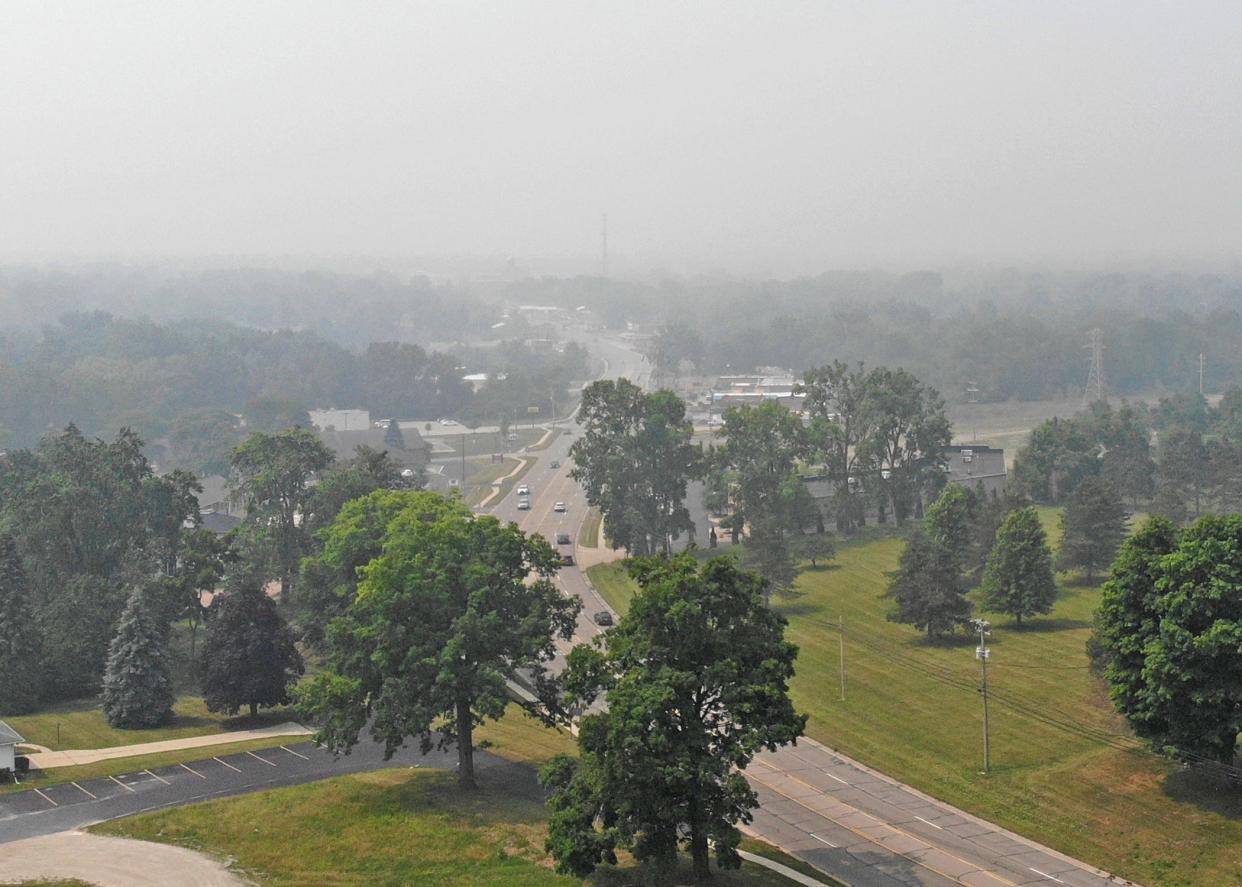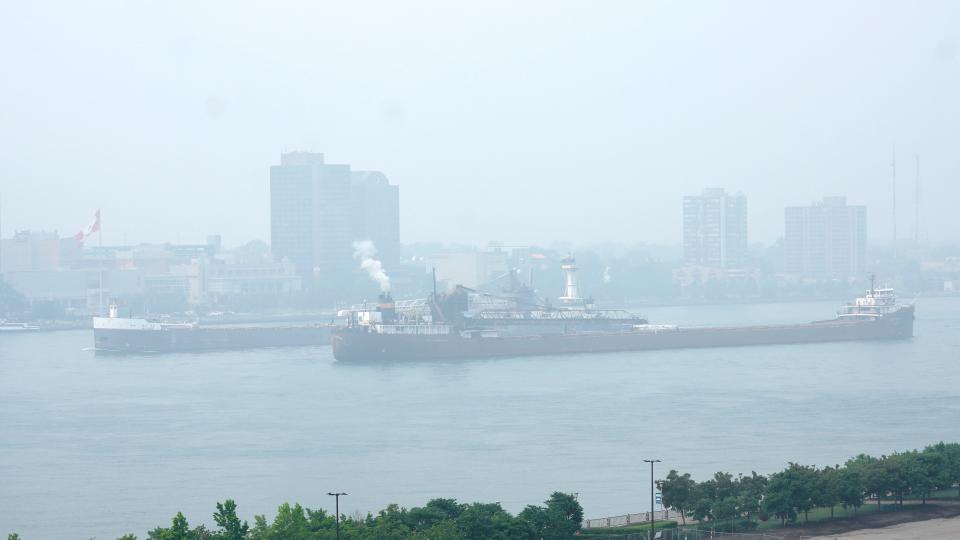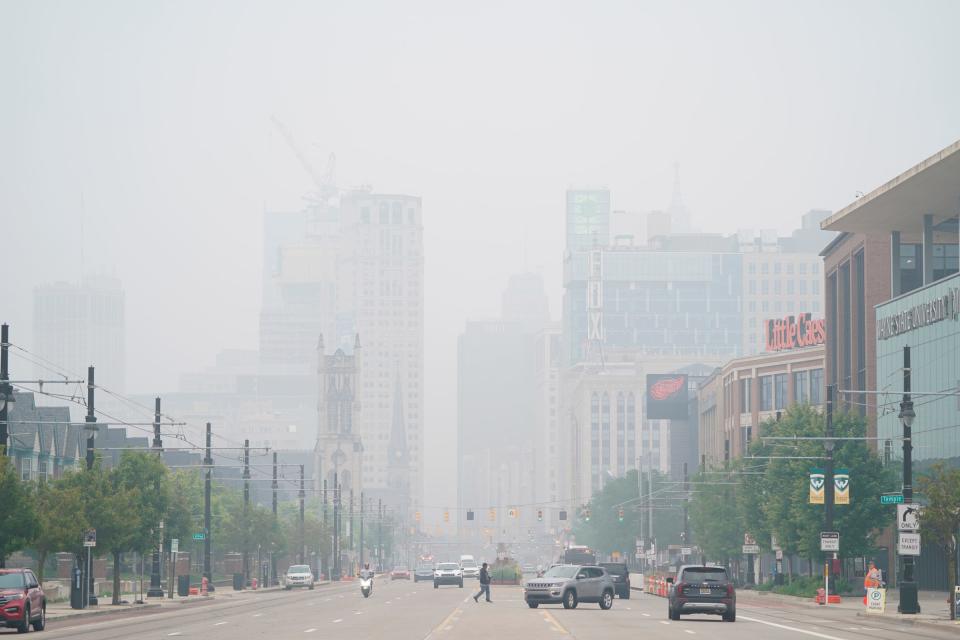Canadian wildfires again choking Michigan's air: 6 questions answered

For the second time this month, smoke from Canadian wildfires is causing an acrid haze over the Great Lakes region, prompting air quality alerts showing southeast Michigan with smoke-related pollutant levels that are "very unhealthy" or "hazardous."
The Detroit Free Press sought answers for why this is happening, what people can do to protect themselves, and what the future might hold. Spoiler: We'd better get used to it, though it may not always be this bad.
Canada has wildfires every summer. Why is their smoke so bad over our region this summer?
Two reasons: The historic scope of the Canadian wildfires and an unusual summer weather pattern for the Great Lakes region.
This has been no ordinary Canadian wildfire season. The same high temperatures and dry conditions that made Michigan a tinderbox in late May and early June have dominated in Canada as well. More than 8.1 million hectares of area — a little over 20 million acres — have burned in wildfires across Canada, the most the Canadian Interagency Forest Fire Centre has ever recorded. The previous high was 7.6 million hectares burned in 1989 — but that was over an entire, April-through-October fire season. We're not even out of June yet.

"It's been unprecedented," said Jennifer Kamau, communications manager for the center. "There have been a lot of large fires across the country at the same time."
Kamau said Canada has 482 active wildfires across the country right now, including 239 fires considered out of control.
Last year at this time, only 1 million hectares of Canadian forests had burned in wildfires.
All of Canada's firefighting resources have been put to use, and the nation has now turned to other countries for help with its wildfires: The U.S., Mexico, South Africa, Australia, New Zealand, Spain, Portugal, France and Costa Rica have all provided personnel and equipment to help, Kamau said.
Wildfires have been particularly pronounced in the Canadian provinces of Alberta in the west and Nova Scotia in the east, and now large wildfires have ignited in Ontario and Quebec, "which is probably from where you are getting your smoke," she said.
More: Wildfire smoke likely sending Metro Detroiters to ERs with breathing problems, doctors say
That takes us to the Great Lakes weather. Normally in summertime, the jet stream, the prevailing wind pattern in the upper atmosphere, takes warm, moist air from the south and west into the Great Lakes region. But this summer, the jet stream is often flowing from the north and east — and bringing Canada's wildfire smoke with it.
"I just don't remember the last time we saw smoke drift from the Canadian Maritimes back to the west into the Great Lakes region — from a meteorology, climatology standpoint, that's pretty hard to do. But we saw it this year," said Jeffrey Andresen, a meteorologist and climatologist with Michigan State University's Department of Geography.

Is all of this wildfire smoke harmful to health?
It can be.
"We are most concerned about the very, very tiny particles that can get down into the deepest portions of your lungs," particulate matter 2.5 microns or less in size, known as PM 2.5, said Dr. Natasha Bagdasarian, chief medical executive with the Michigan Department of Health and Human Services.
"It can cause lung inflammation and other chronic issues over longer periods of exposure, but also acute and immediate issues, especially in those with underlying heart or lung disease, the young and the elderly, and pregnant women."
Lungs can become damaged from the irritation and inflammation over longer periods of exposure, Bagdasarian said. But she noted that these high levels of smoke pollution "can change day to day, hour to hour, minute to minute."
More: Stellantis $5,000 fine for repeat odor violations called 'a joke'
Dr. Daniel Oullette, interim department head for pulmonary critical care medicine at Henry Ford Health, said the pulmonary clinic is seeing more patients with breathing-related problems this spring and early summer.
"The quality of the air is one factor, but the warm winter and spring have also led to high pollen counts, and this contributes as well," he said.
The biggest issues Ouellette says clinic staff is seeing "relate to worsening problems in patients with asthma and emphysema."
What can people do to protect themselves?
First, understand the quality of the air where you are. The U.S. Environmental Protection Agency provides continually updated air quality monitoring results at its website www.airnow.gov, and also through a free, downloadable telephone app. Local air quality is measured there on both a 1 to 500 scale, and with color-coded guides. The higher the number, the more pollution in the air and the greater the health concern.
When the colors are more in the yellow to orange range, children, elderly people and those with preexisting medical conditions should avoid strenuous activity outside. As the color code trends toward red, purple and maroon, everybody should avoid outdoor activity to the extent possible.
"One of the things we are really advising people to do is pay attention to what that number is, what the guidance is at that particular level," Bagdasarian said.
People can also sign up for air quality notifications for their area at the EPA's www.enviroflash.info.
More: Michigan's poorer, minority neighborhoods become 'sacrifice zones' for increased pollution
Reducing the amount of time spent outdoors during bad air quality days is the key, Bagdasarian said.
"Make sure windows and doors are tightly sealed," she said. "Turning on an air conditioning unit may provide additional filtration."
The air filtration and purification devices many bought during the COVID-19 pandemic may help with wildfire smoke pollution as well, Bagdasarian said. Check to see whether the device filters PM 2.5 particles.
Those who can't avoid outdoor activity are urged to wear a protective mask that tightly seals to the face and is designed to filter out tiny particles.
"We are not talking the surgical masks or cloth masks that many people used during COVID," Bagdasarian said.
People should avoid wood stoves, wood fires and any other "things putting extra pollutants into the air," she said.
Local health departments are providing temporary shelters for homeless people to have a place to go with clean, indoor air, Bagdasarian said.
When is this smoke leaving our area?
Environment and Climate Change Canada, the nation's equivalent to the U.S. Environmental Protection Agency, has a smoke transport model forecasting how wildfire smoke will move. Models currently show the smoke gradually moving out the Great Lakes region to the northeast back into Canada through this weekend.
"Of course, it may not be the last of it for the season," said Richard Carr, a fire research analyst with the Canadian Forest Service.

What does the rest of this summer look like?
In the short term, the Great Lakes region is expected to get more frequent chances of precipitation, Andresen said. But longer-term forecasting into September calls for warmer than normal mean temperatures and below-normal rainfall.
"That's certainly a red flag for a number of reasons," he said.
The lack of rainfall over much of the past month means there's little moisture stored in the soil, which ordinarily provides a kind of reserve for plants for hotter, drier periods of the summer.
"This year, we don't have that because it's been used in the last two months," he said.
In Canada, higher-than-normal temperatures and lower-than-normal rainfall is expected to continue to dominate through August.
What does the future look like? Is wildfire smoke our new summer normal?
In a weather forecast update Wednesday, Environment Canada meteorologist Steven Flisfeder predicted wildfires will become "more probable" as human-enhanced climate change from fossil-fuel burning continues.
"The likelihood of forest fires becoming a bigger concern in coming decades is something that is consistent with climate change," he said. He noted climactic modeling showing increasing temperatures and drying through the remainder of the century, particularly if efforts aren't undertaken to significantly reduce greenhouse gas emissions.
But the situation remains highly variable from summer to summer.
Andresen noted the Great Lakes region is now having longer growing seasons by a couple of weeks — which means it also has longer fire seasons. This year, Michigan experienced an "extremely rapid transition from what was almost excess moisture as recently as early April" to rainless conditions for weeks. That can cause a lot of greening in the forest that then dries, dies and turns into fire fuel.
Those "flash-droughts" could become more of a concern even if precipitation increases in the region, he said.
Said Bagdasarian, "Folks out west have dealt with wildfire smoke and air quality issues related to it for much longer than we have. This is not something that has been part of the steps Michiganders usually take to keep themselves safe and healthy.
"Monitor the (air quality) websites, download the app," she said. "Over the entire summer, not just over the next couple of days, talk to friends, family members and community members about this issue. Consider moving outdoor events indoors on bad air quality days, or canceling or postponing youth sports on those days."
Contact Keith Matheny: kmatheny@freepress.com.
This article originally appeared on Detroit Free Press: Canadian wildfires again choking Michigan's air: 6 questions answered

